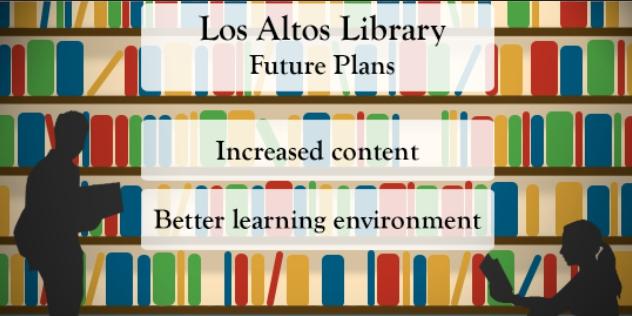City Library Plans Future
The Los Altos Library discussed the possibility of renovating the library in the future. Graphic by Vanessa Mark.
On Thursday, September 10, the Los Altos Library held a presentation led by the Aspen Institute to discuss the plans in improving or completely renovating the library in the future. The two features they focused on were increasing content for people through all platforms of learning, and creating a better learning environment through better architectural designs and layouts.
The two speakers who spoke at the presentation were Aspen Institute fellow and former California State Librarian Susan Hildreth and Principal of the Group 4 Architectural Firm Dawn Merkes. The night’s event focused on how to keep a library relevant in the 21st century society and how to specifically benefit the community that a library is built around.
“Really, we want to sustain and broaden the position of a library which requires us to be thinking about what I library is and how it can drive opportunity and success in today’s world,” Hildreth said.
She explains that this is how the library can adapt to the ever-changing world and still be a place for youths and adults to continue learning as they did in the past.
“I want to talk about is aligning with community goals,” Hildreth said. “So what we found is that public libraries that create services that prioritize and support local community goals will find the greatest opportunity for success in the years ahead.”
She referred back to this thesis point ever so often in her presentation and she called for libraries to become more personalized to the city that they are established in, instead of using the same format as another library. Hildreth pushed for bettering the library staff and adding more ways for customers to interact with the library and to get the most out of the content of the library.
Later in the presentation, Merkes held a Powerpoint slideshow on how the architectural design of a library can also personalized to the city it is built in to reflect the communities’ values.
“[We have]taken some examples from a few of our projects and put them together,” Merkes said. “to show you how we supply these principals to actually [finish] projects.”
While creating the Walnut Creek Library, the Group 4 firm ran into some trouble with the local businesses who wanted to use the land that was going to be the library to become a parking lot. This along with the potential demolition of the nearby community-favorite park led a problem, but the Group 4 team manages to figure it out.
“[During a meeting with the local store owners we came to an agreement] and it was really the ‘Ahah!’-moment, the conceptional design was presented, underground parking, expanding the park, leaving the private property alone [and] coming up with the solution that really worked for everybody,” Merkes said.
The presentation came to an end after Merkes finished her presentation on what she learned from building many local libraries, and the focus of the meeting was clear: a library must fit the needs and benefit values of the community it is in to succeed in the future.




